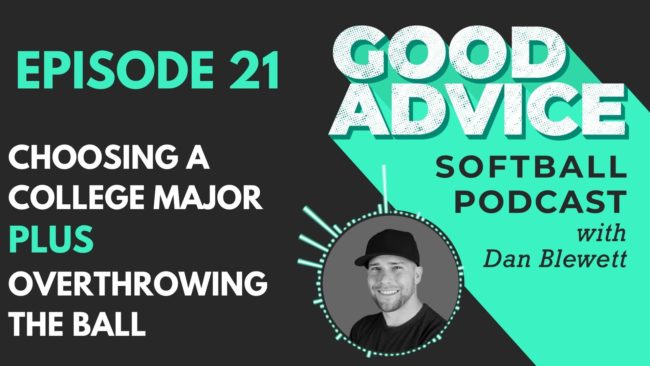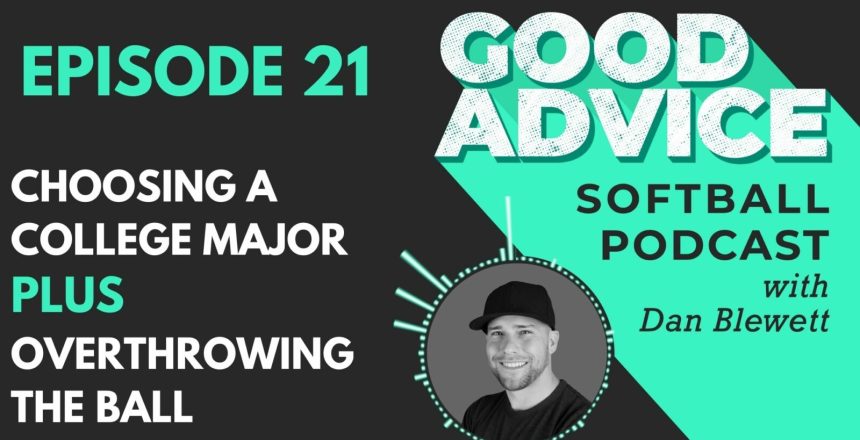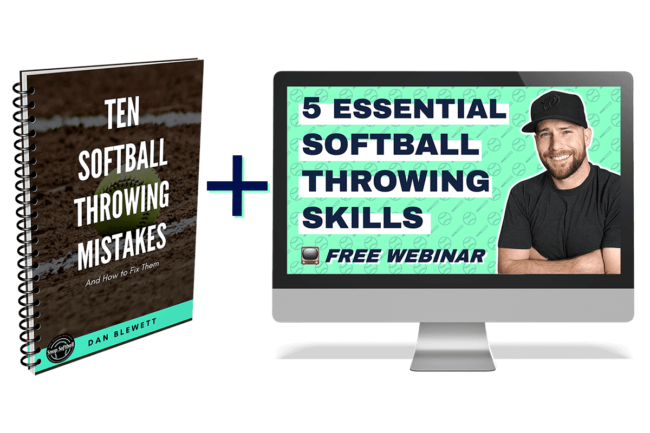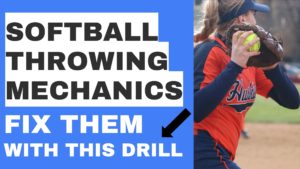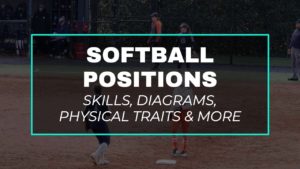*This article may contain product links which pay me a small commission if you make a purchase. Learn more.
In this episode, Dan gives advice on the different factors to consider when choosing a major as a college athlete – did you know some majors are essentially not allowed if an athlete wants to be on a certain team? Also, Dan answers a listener question about what causes overthrows to first base.
Links: Try the Early Work Strength Program for free here.
To submit a question for the Good Questions Q&A segment, make a voice recording and email it to Dan at hello@danblewett.com. Want to support the show? Enroll in one of Coach Dan’s online throwing courses or his mental skills course. Use code GOODADVICE to save 20% on any course, just for being a listener. Sign up for Dan’s Email list and get his free throwing eBook, and follow up with him on the interwebs: YouTube Channel | Twitter | Snapsoftball.com
Podcast: Play in new window | Download
Subscribe: Apple Podcasts | Spotify
EP21 Transcript: EP21 – Choosing a College Major Plus Overthrowing the Ball
You’re listening to the Good Advice Softball Podcast. I’m Dan Blewett. And on this show, you’ll learn how to help the softball player in your life. Sharpen her skills, improve her mindset and find new confidence through softball.
Alright. Welcome back to the Good Advice Softball Podcast. I’m your host, Dan Blewett. And on today’s episode, we’re going to cover two topics. Number one. Majors in college. So this is something that doesn’t get enough press. And I appreciate, a parent recently suggesting this topic to me, because you know, where you go to school and what you major in has a major impact on your college athletic schedule.
And there’s a lot of schools that will just downright say, look, if you want to come here and play softball, you probably don’t want to choose X, Y, and Z majors, which is something just to be aware of. In our second topic. I got a great mail-in question. So we’re going to listen to that and we will cover, overthrows to first base.
And again, good question here. So definitely worth covering in this podcast.
All right. So let’s kick off with college majors. So the one thing to remember here is that, you know, the old NCAA, anecdote that. You know, or I guess it’s a slogan that, you know, everyone’s going to go pro in something. And for the vast majority of us, it’s going to be in something other than sports.
Right. So even though they put it a little more succinctly than I just did, this is true in the vast majority of sports in general, the collegiate level. And it’s even more true for female sports. Obviously there still as the NPF, which is pro softball, there’s a newly called Athletes Unlimited, which is still an upstart.
So you know, yet to be seen how long that lasts. But with these two options, most players like the slogan goes, are going to go pro you know, in a career. And that’s obviously everyone’s path at some point. So that being said, what they don’t tell you a lot of times is with. You know, the rigors of division one, softball and baseball falls in this category too, where they played just a lot of games.
It makes it kind of difficult to have certain majors. So every school is going to be different. Every coach is going to be different, but here’s the thing to know that when you’re. Programming out your college schedule. There are many majors that do lots of labs where they have lots of collaborative work or their higher level classes are just always in the afternoon.
Like they don’t have morning classes. And so typically what happens when you get on campus, which happened to me and happens to pretty much everyone else is that you have to make your schedule fit with your softball schedule. And of course, in my case, my baseball schedule. So what that typically means is it’s, you know, you could probably guess this, but.
They say, Hey, you know, don’t schedule any classes from like, you know, 2:00 PM to 6:00 PM, something like that. So obviously those are prime practice hours. And depending on the program, it could be, you know, even a longer timeframe. So, but typically it’s like that two to six window. Right. And also depends on like transportation to your field.
You know, most schools have their field on campus. Some don’t though. So it might require like a shuttle bus or something like that. Like I know, you know, there’s a couple of colleges that have that, where they have the off-site, field, you know, like here in DC, most of the schools have their field offsite.
So with all those different factors, you have to consider whether, you know, major that’s going to have all of your labs. Like, you know, the, the sciences are typically a culprit here. If you have, you know, chemistry lab at 3:30 and that’s going to be your life from junior and senior year on until you graduate, that’s going to be a very incompatible major with playing a division one sport, or even division two sport division three sport doesn’t matter.
And so. All these things are important to understand. And this is the reason why a lot of players who maybe aren’t as passionate about softball or who are just more passionate and planning rightly so for their future, academically, choose to say, Hey, I’m to rather going to go, you know, I’m going to go to a great D three school instead of a D one school.
That way I can still have my fun and enjoy playing softball and still be serious about it. But at the same time, You know, I can put my academics first and, you know, D three schools have a lot less rigorous schedule compared to a D one. For example, of course there’s many, many levels of college softball.
There’s D one D two D three. There’s also varying levels of Juco. There’s NAIA. So there’s lots of different levels and they all have different rules and every school is going to be different about where they prioritize athletics and otherwise. Now, I think this is slightly less the case with softball than perhaps some men’s sports, but you know, in some men’s sports and baseball is definitely one of them.
You can arrive on campus and they’ll tell you, point blank, you cannot be a pre-med major and play baseball. This school. They’ll just tell you that. Or you can not be this major and play at this school. And of course, Most of them will tell you that well, in advance. So you make a decision with your eyes wide open, but some of them won’t and a lot of them will just maybe steer you to one major or the other.
And this can be again, a wake up call for a lot of people, because if you go to a school and say, I’m going to take computer science and you get there and like, yeah, you can’t take computer science. If you want to play softball, you’re gonna miss too many practices. Well, that’s a big problem, isn’t it? So these are all just good questions to think about and obviously good questions to ask a coach on a recruiting visit and just to try to be upfront with everyone and just, and of course here’s the big thing.
It’s a shame to say, like, I’m going to, well, it’s not a shame, but for a young athlete, you shouldn’t have your life planned out already. If you know what you want to major in. That’s wonderful. But many of us. Myself included did not. And many of us later on in life still don’t to know exactly what they want to do with the rest of their life.
So that’s another thing that’s problematic. Whereas you might start off as a freshmen and say, you know, I’m going to be a journalism major. I’m going to be a sociology major or accounting major and a year later and might be like, I hate every bit of this. So I’m going to switch majors. How does that affect me?
And it can be really tough to bounce back from that or to catch up where you might be like, crap. If I had done a different, you know, if I had done this major that I’m choosing now as a freshman, then I wouldn’t have had to take all these classes that are now conflicting with, you know, with practice and with games.
I mean, it’s, just difficult in general, you know, I think you sometimes think of like the big sports, like football or basketball. Obviously football is not a women’s sport at the varsity level, but. I think you sometimes think of those as being like the most time crunching and rigorous, but really it is softball and baseball at the college level because there’s so many games and obviously they have really long, very time inefficient pregames.
I used to laugh where our lacrosse team, at my Alma mater would show up. So on the Saturday we had a double header we would show up at like, I don’t know, 9:00 AM and we’d have like a 1:00 PM game, something like that. So we’d show up, we’d change. We’d report to the field. Maybe 10, you know, in baseball typically has a long, pregame and we would start our pregame and lacrosse would show up.
After we got to the field, starting our pregame, they would do their pregame play their full game, and the entire place would clear out before we had started our game. So their entire pregame. Game and post game fit within baseball’s pregame. And of course, softball doesn’t have quite as long of a pregame as baseball does.
But it’s still long compared to other sports. And obviously you’re playing lots and lots of games. The game schedule is way more than other sports. So with all that being said, It’s hard to be a successful student at the college level. And this is why a lot of students, will choose, you know, their academics over their sport.
If they’re not just like crazy, crazy passionate about playing at the highest possible level that they can. So these are all just things to consider. And the major thing is something to definitely do some digging on. So if you really want to take biochemistry, if you really want to take one of these science heavy, which most of those classes that it seems like always the sciences tend to have lots of labs and collaborative work.
That just can’t really be, you know, you can’t take it on the road with you. You have to do an in person, a lot of those labs and science majors. They ended up being very conflict heavy with your sport. So again, in case that’s news to you, which it was news in my family when I got to college, of course my majors did not conflict.
I, was undecided for most of my freshman year. And then I ended up choosing philosophy because I was like, I don’t care about any of this. So it was philosophy seems kind of all right, so I’m gonna choose philosophy as it turned out, it was good for me. And I’m actually really thankful that I made that choice.
Even though it was sort of unbeknownst that it would be. As good for me as it ended up being. But, you know, I think with, especially the way the world’s changing, and this is my last sentiment here with majors, the world’s changing a lot and sure you can be an accounting major and, you know, be on a track from, you know, year one.
To be churned out of college, ready to be an accountant. And that’s great if you know that that’s what you want to do and you want to build a career track. That’s great. There’s also just so many more ways to make a living today than there were five years ago, 10 years ago, especially 20 years ago where you don’t have to have a certificate or a degree in a certain field to be that thing, you know, you can have, I know the liberal arts and the fine arts, like my major was a liberal arts degree, obviously.
Those majors are coming back because people are saying, I just need, I need employees that I can train well, who are quick on their feet, who are smart, who can make good decisions without being constantly supervised and told what to do. And a lot of those heavily thinking majors like philosophy, are good for that.
And I would put myself in that same bucket that I think, you know, I could be valuable to an employer in almost any discipline. If I was, you know, leaving college right now. To to make sensible decisions. Right? Well communicate well, and in general, just think critically on the job. And I think that’s what most employers need.
I know now that I have a couple of people working for me, that’s the skill I desire most. So I would also urge parents and players not to. To totally sweat your major. Now, if you do want to be a doctor, if you don’t want to be a biochemist, if you want to do you want to be a biologist, you obviously have to be on those tracks.
So obviously there’s not leeway in every single major, you can’t side hustle your way in to be a, you know, and to be a neuroscientist or whatever it is. So obviously there’s a lot of different, different paths. And my advice is not going to apply to all majors and all career tracks. But. Again, it’s a, complex thing being a student athlete.
And that really is what it is. You’re not just an athlete. You’re not just the student. The student athlete moniker is tough to maintain. It’s tough to get really good grades and for the kids that do it, I mean, hats off to them. And this, again, just figuring out how your schedule fits with your major is just another aspect to consider.
All right. In our second segment today, we’re going to cover a great question sent in by Joe. So thank you, Joe. Hey, Dan loved the show. What did ask a quick question? Third basement or shortstop throw to first. Do you have any suggestions or tips for throws that are continually over the first basement’s head, any drills or anything that you would suggest doing technique wise to get those throws down?
Thanks a lot, man. Love the podcasts. All right. So really good question. What happens? What is happening when a player is consistently overthrowing high over first base. So without seeing a specific player, this is, these are the first two things that come to mind. So, number one, you always use your torso to some extent when throwing you do it a lot less.
So as an infielder, but the more momentum you have and the more you move your body towards your target, the more your torso, your upper body will start to move towards your target. So as you release the throw. Your chest will move towards first base and sort of have a lower angle towards first. So if you look at baseball pitchers, as an example, when they release the ball, their body is at like a 45 degree angled, lean towards home plate.
Outfielders also have a pretty significant lean because they have so much momentum. And thus their upper body is moving. I mean, it’s got momentum and it’s, got to continue towards the target. So with infielders, they have less of this, but the more momentum they get and the more they move their feet, the more they can sort of push their chin and their chest towards their target.
And when you do that, It helps to drive the ball down. So one of the reasons the ball goes up is when players are standing straight up and down, because when they’re standing straight up and down, they’re not getting to use as much of their upper body and their glove side to sort of crunch them down and get on top of the ball.
So the way we get on top of the ball when we’re throwing is that we use our front side to pull down. And that means obviously if you’re playing third or short, you’re going to be a righty thrower. So when your left arm. Your glove arm, it should rise slightly upwardly angled towards first base. And I talk about shoulders tilting upward, in lots of mechanical videos for softball and baseball.
So your shoulders need to be at the very least level or slightly uphill when you’re about to make an overhand throw. And when you do that, then you can take your left arm, your glove arm, and you can sort of pull down and pull. You sort of crunch your torso angle down. That’s what helps getting your arm up.
Get your arm at your arm slot higher. So you’re, if you don’t have that front side angled pulled down, you tend to go side arm. And I have a bunch of YouTube videos that talk about that. So your front shoulder goes slightly upward and then your front, your glove arm crunches you down. And when you do that, it helps to sort of speed your arm up and get your hand above the ball.
So when players are overthrowing, Number one. And I always go back to this. If you look at the highest level players in the world, whether it’s softball or baseball, the, command tool, you know, commanding your throws, having good control, throwing lots of strikes. It isn’t purely mechanical and especially in baseball.
And I use that as just an analogy, a lot. There isn’t really like a significant, when you look at a pitcher who walks two batters per nine innings versus a pitcher that walks four batters per nine innings in the major leagues, there’s no mechanical difference. You can’t say, Oh, well, he walks twice as many batters because he does this with his mechanics.
That’s not the case at all. It’s the same thing. When you look at hitters and the major league level, or the division one level of softball or pro softball, there’s not like, Oh, that’s why she’s a two 70 hitter, because look at her swing versus that’s why that, hitter hits .310. All of their swings are really, really good at that level.
Right. And so the intangibles and the getting the ball, the barrel of the bat to the ball becomes paramount at those levels. It’s not really about their swing. Sure. Some players definitely have better swings and others at the high level, but all of them. Are very good swings and all players in the major leagues have very good throwing mechanics.
Now, my point in all that is at some point, there has to be a mental desire to get the ball down. And that seems like a cop-out, but I’ll share a quick story when I was in college. I was a pitcher obviously. And I was just consistently up in the zone. I wasn’t good at throwing the ball at the bottom of the kneecap, which was something our coaches preached and preached and preached and preached and preached.
And I got away with it because I later learned that I had a kind of like really fast spinning high spin rate, fast ball that sort of like played well when I threw up in the zone, hitters tend to pop it up or they tend to swing underneath it and I didn’t get hurt very much up there, but the point was, I wasn’t good at getting the ball down.
And part of the reason I wasn’t good at getting a downloads because. I was never getting really, really punished at doing it. And so fast forward, many years, like six or seven years, I’m coming back from elbow surgery and I’m in spring training with, a team where probably half of the roster was former AAA and major league pitchers that have been released.
You know, they’ve been bounced out of the highest level for whatever reason. And I was in spring training amongst them coming back from surgery. And, I watched the guy who was in the big leagues, throw his bullpen right before me. And like literally every throw he made was just like pounding the bottom of the strike zone.
Just bop, bop, bop, you know, fastball, just screaming downhill right below the catcher’s kneecap. It’s like he couldn’t not throw it at the bottom of the kneecap. And as I watched this bullpen, I was like, I got, I just got, Oh, no, because I knew for a fact that I had never thrown a bullpen like that in my life.
I’d throw some at the bottom of the knees. Then I throw some right down the middle. I throw some at the chest. I just was all over the strike zone and I always kind of got away with it. And, but at that moment, I was like, if I throw my normal bullpen, I’m going to stick out. I don’t look like that guy. I can’t do what he does.
And so at that moment, I was like, I have to throw a bullpen this exact same way that he did. And the level of focus that I had in that bullpen was. Unlike any bullpen I’d ever thrown in my life, because it was a, if I don’t throw the next pitch at the bottom of the kneecap, I’m getting cut. I’m getting sent home.
That was my mindset. And it was a very real mindset. And so that bullpen something like unlocked in my brain where I suddenly had a much deeper level of focus that I can now sort of access that I didn’t have before, because I’d never been placed in a situation where I was like backed into a corner and I had to do a thing.
Right that moment. And my point here is, and I’m going to get back to mechanics a little bit before we wrap, but. A lot of young players, because I’ve worked with a lot of players, boys and girls, a lot of them, they think it’s all about mechanics. They get the ball, they throw it and it doesn’t go where they want.
And they were never really in the throw. They were just making a throw, but they were never really in the throw. Like they’re not in tune with their body. They’re not in tune with their mechanics. They don’t really know what makes a ball go down. And I’ve had so many conversations with wide-eyed baseball, pitchers on the mound.
Who just thrown seven fast balls at head height without making any adjustment. And I walk out there, it’s like, all right, you’ve just walked a guy on four pitches and now you’ve thrown the next three all at eye level, just the same. And I’m like, what’s going on? And they look at me, but what are the, I just don’t know where it’s going.
I don’t know what to do. And that’s that same thing. Sometimes with infielders, they can throw the ball, they can air mail, air mail, air mail. It. And because they’re not really in the moment when they make that throw, they don’t know what happened because it’s almost like they weren’t there. Right. So imagine if you took a swing with your eyes closed and you missed, you know, pitches coming, you close your eyes and you swing.
Well, how do you diagnose where to swing next on the next pitch? Or what was wrong with your swing on the previous pitch? It’s not a perfect analogy. And that’s kind of what it is. Like they’re there for the throw. They’re there for the pitch. They’re there for their swing, but they’re not really in tune with what they’re doing and why.
And so a lot of times when I work with players and especially with softball, when I work with softball players on their mechanics, They’re going to make some overthrows, a lot of them when they start to make tweaks, because it’s just like your bazooka now has more gunpowder in it. And so if you had a dialed in to a certain target, now you put more gunpowder.
Now you overshoot your target. Right? It’s a very common thing. A lot of players that take my online throwing course they’ll report back in the first week. They’re like, Hey, she’s definitely throwing harder, but she’s like, airmailing everything where my head, what do we do? I’m like, well, Honestly, that’s normal because again, for the exact reason that I said, there’s just more gunpowder in the gun, she just needs to make the adjustment and she will, you just gotta kind of pull down hard with your front side.
As I kind of talked about earlier, make sure she’s going uphill. It keeps her weight back a little bit. And then she pulls herself forward. Almost like doing a Cartwheel with that glove side and gets the ball down. And at some point. There’s no mechanical fix that just like magically makes the ball go to the first baseman’s chest.
Is there? No, like you have to throw it there and you have to be in tune with what a bad throw feels like versus what a on target throw feels like. And that’s something that you have to be extremely presently aware of to, make that adjustment and feel. This is what a high throw feels like.
This is what I, when I do this with my glove side, this is what gets me on top of the softball and then drives it through her chest at first base. So that’s two of the three parts of it. So number one, if your mechanics are fine, like you have good, decent throwing mechanics, you need to make sure you pull down hard with your glove.
Side. That’s what sort of speeds your arm up to get over top of the ball. Number two is the mental factor in the focus factor is a very real. Issue with overthrows, with, you know, hitting with pitching with any of it. There’s this huge part of throwing that’s autonomous that’s mind, body connection, but it’s also focused.
So even though I’m not consciously focusing on making the next pitch, cause I’ve made 50,000 in my life. all that prior focus on 49,999 of them. Allows me to be unfocused and, and focused on my target and not focused on my mechanics and still make and do everything right. Mechanically. So a lot of parents, I think, forget that it’s, or they just don’t know that it’s not just mechanics, there’s a ghost in the machine who has to be trained what to do.
And then the last part of this is a lot of softball players throw the low elbow. A lot of them, the majority of them are almost. So if you have, if you have rough throwing mechanics, chances are you have a low throw elbow elbow, and with a low elbow, this is why it’s especially problematic. That the harder you try to throw a ball.
The more, the ball goes up and that’s true with good throwing mechanics too. Like when baseball, pitchers, overthrow, or when a outfit a really Uncorked one in softball or baseball, it goes up right. That’s because your body starts going too fast and your arm lags behind. And so there’s always that balance there.
But with, with the low elbow, it’s, it’s fundamentally different because as you accelerate the ball, The elbow drops down and then it tries to catch up and it gets below the ball. And as it accelerates, it’s literally, you can watch your hand going upward. Whereas when you have good throwing mechanics and your shoulder blade is pulled back as your torso rotates, first, the arm goes back, but then it climbs, it climbs over the ball a lot earlier.
Index and its acceleration part of the delivery. Whereas when you have a low elbow, it climbed over the ball very, very late. And what this teaches girls to do is when they do try to throw harder and they’re like, I’m going to put some oomph into this one, the ball goes up. And so what they get. Stuck back in the habit of, is there like, Oh no.
When I do that, it goes up. So now I got to back down a little bit not. And then now not only are they throwing with mechanics that don’t allow them throw very hard, but now they also have to meet her themselves and take a little bit off to make sure the trajectory is right to throw that mortar to first base, essentially.
So part three of this is that if you have a low elbow flaw, In your throwing mechanics, the harder you try to throw the ball, the harder it will be to get it down. And there’s not a whole lot you can do about that because if you look at the mechanics of it, the, again, the elbow dips free long portion of the acceleration phase.
And then as it starts to accelerate above the ball, it’s very, very late. And it’s just like the ball’s gone at that point. And so it’s going to have to go up. So that’s the other part of it. But again, no matter what mechanics you will have today, There’s still again, the ghost in the machine, you, as an athlete can throw the ball to first base any darn way and get it and get it there and on the, at their chest.
And this is the same way for a pitcher. You can throw, you know, you, you watch infielders, they can throw on the run from any arm angle at any speed running any direction. And it’s phenomenal. It’s so it’s such an athletic movement. And you say, well, how’s that possible? It’s because they just practice it a bunch and they don’t let their mind get in the way and screw it up.
And they’ve done enough where their body knows how to trajectory, you know, in vector the ball in to first base. And so, again, it’s not just mechanics. And players can, you know, if they’re focused enough in practice, say, all right, I’m going to get this next ball down. Let’s tinker, let’s pull my front side and see what happens.
And then when they say, okay, that’s the cause and effect, when I do this, I can actually get the ball down. Still throw it hard. Then they’ve got to repeat, repeat, repeat, repeat, repeat, and practice, practice, practice. And then hopefully that becomes their new muscle memory as not an issue anymore. So, Joe, thanks for the question.
That’s a very good one. Hopefully that long diatribe made some sense. You know, there’s, again, there’s a lot of, I think this is what’s frustrating for parents. Is there a lot of parts that there’s a lot of parts of the game that no one else can intervene with that they just have to do it on, do it themselves.
And again, going back to some of those mound vitis I’ve had with baseball pitchers. It sucks for him. It sucks for me because I know full well that I can’t fix him. There’s no like mechanical thing. I’ll give him a mechanical thing to try. But at the end of the day, that pitcher, who’s throwing seven straight fastballs of the eyeballs.
He’s got to figure out a way mentally to get his body, to do. What it is capable of doing, and that’s just like the bottom line. Sometimes you can’t hit the ball for your daughter. You can’t throw the ball for your daughter. You can’t feel the ball, or you can’t run the basis for your daughter. You can teach him the proper mechanics, but once they’ve got the mechanics, they still have to do the, the thing to get the proper output.
And again, I think that’s, what’s really powerless for a lot of parents and my heart goes out to you. I don’t have any kids out there yet, so. I, but believe me, I’ve had plenty of a nail biting anxiety filled games as a coach, so I can empathize at least a little bit. All right. That’s it for today.
Thank you for listening. Thanks for the listener question and be sure if you’re listening. Shoot me an email. Grab a quick, a quick soundbite on your phone. There’s a audio clips app. That’s not exactly what it’s called, but it’s really easy to feel more recording. And, you can just shoot over to me at hello@danblewett.com and we’ll play it on the show and answer your question.
Well, that’s all the good advice I’ve got for today. If you enjoy the show and would like to support me while also helping yourself enroll today in one of my online softball courses, my She’s Got a Cannon throwing courses, come with pricing plans for any budget. And my Resolute Athlete, mental skills course will help your daughter or team build the mindset of a champion.
Enroll in any of my courses through the links in the show notes and save 20% with code good advice just for being a listener. Be sure to subscribe to my weekly email list where you’ll get updates on all my new videos and episodes, nearly 4,000 people get my emails and you should to sign up for the link in the show notes.
Lastly, who do you know, who can use some good advice? Please share this podcast with a friend, subscribe on iTunes, Spotify, or wherever you listen to podcasts and subscribe to my snap, softball, YouTube Channel, where you’ll find this podcast and hundreds of softball, instructional videos. Back when I was a player, I was always thankful for good coaches and good advice.
I’m Dan Blewett and I’ll see you next time.

